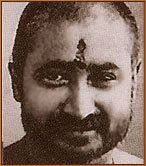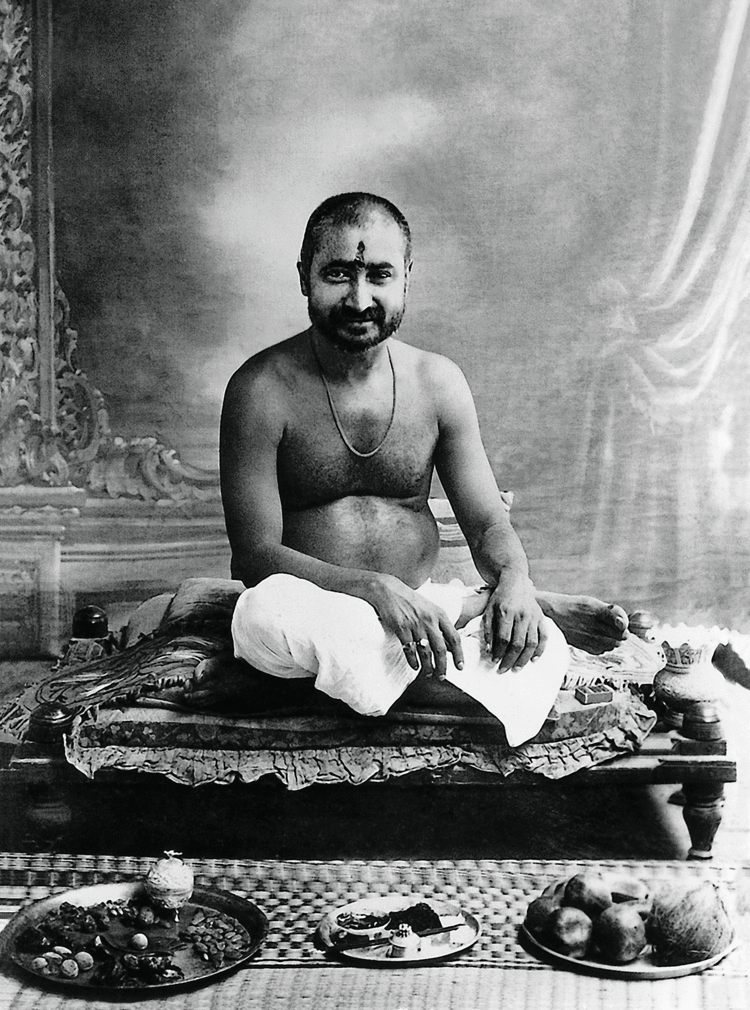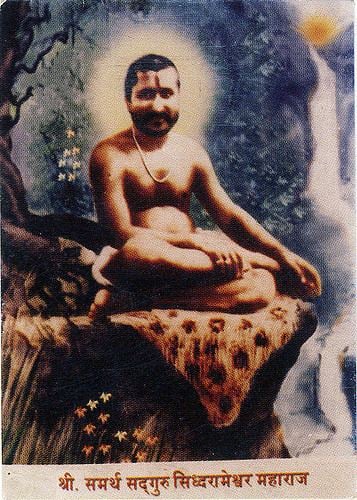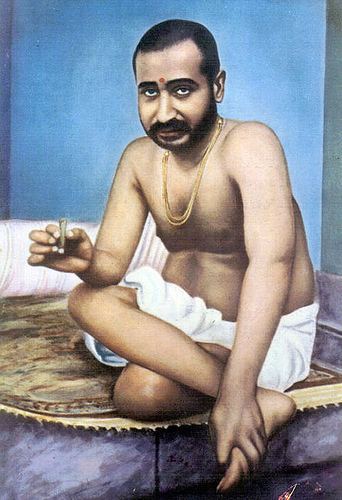Name Siddharameshwar Maharaj Samkhya Kapila Shuddhadvaita Vallabha Acharya Dvaitadvaita Nimbarka | Vaisheshika Kanada Yoga Patanjali Died 1936, Mumbai | |
 | ||
Books Amrut Laya: The Stateless, Master Key to Self‑Realization, Master of Self‑Realization | ||
His holiness sri siddharameshwar maharaj
Sri Siddharameshwar Maharaj (Marathi: श्री सिद्धरामेश्वर महाराज; Kannada: ಶ್ರೀ ಸಿದ್ಧರಾಮೇಶ್ವರ್ ಮಹಾರಾಜ್ ) (1888–1936) was a guru in the Inchagiri Sampradaya founded by his guru Shri Bhausaheb Maharaj, a branch of the Navnath Sampradaya, the 'Nine Masters' tradition in India. He was the Guru of Nath teachers Sri Nisargadatta Maharaj, Sri Ranjit Maharaj, and Sri Kadsiddheshwar Maharaj.
Contents
- His holiness sri siddharameshwar maharaj
- Gerd valentinelli gespr ch ber shri samartha siddharameshwar maharaj
- Biography
- Atma Vidya
- The koshas
- The Birds way
- Usage of classical texts
- Lineage
- Publications
- Golden Day
- Adhyatma Jnanachi Gurukilli Master Key to Self Realization
- Adhyatmadnyanacha Yogeshwar Master of Self Realization An Ultimate Understanding
- Amrut Laya The Stateless State
- Quotes of Siddharameshwar Maharaj
- References

Gerd valentinelli gespr ch ber shri samartha siddharameshwar maharaj
Biography

Siddharameshwar was born in 1888 in the village Pathri, Solapur, India. Since his childhood he was very intelligent and had very sharp imbibe abilities. In 1906 he was initiated by his guru 'Shri Bhausaheb Maharaj' in Inchagiri in Karnataka India, who taught mantra meditation as the way to reach Final Reality. He was one of the contemporaries of Sri Ramana Maharshi.

In 1920 Siddharameshwar started to set out on "the Bird's Path", the fast way to attain realization, six years after Bhauhaseb maharaj had died. His fellow-students opposed, but eventually he succeeded by himself.

Siddharameshwar died on November 9, 1936 (Ekadashi, 11th day in the later half Ashwin), at the age of 48, giving his understanding to his disciples. It is said that dozens of his disciples became self-realized through his clear and lucid teaching. His samadhi shrine today is located at Banganga, Walkeshwar in Mumbai.
Atma Vidya

Atma Vidya (Self-Knowledge") is the central theme in Siddharameshwar Maharaj's teachings. In Master Key to Self-Realization he describes how the teaching of Vedanta is transmitted to a student. It starts with the meeting with a guru, who tells about the teachings. Thereafter a mantra is being used by the student to meditate and make the mind more receptive. Then the guru explains the teaching further, which has to be realized experientially by the student.
The student has to turn away his mind from external objects and the gross body, and "turn within". By realizing that objects have only a temporary appearance, it becomes possible to develop detachment and to clear one's mental attitude from pride. This is a necessary step to develop Self-Knowledge, and the renunciation of the impermanent, and the acceptance of the permanent.
The koshas
To realize this Self-Knowledge, an investigation of the four bodies has to be made to discover whence the notion of "I" comes. Siddharameshwar Maharaj discerns four bodies:
- The Physical Gross Body
- The Subtle body:
- the Five Senses of Action (hands, feet, mouth, genitals, and anus)
- the Five Senses of Knowledge (eyes, ears, nose, tongue, and skin)
- the Five Pranas or vital breaths (vyana vayu, samana vayu, udana vayu, apana vaya, prana vayu)
- the Mind (manas)
- The Intellect (Buddhi)
- The Causal Body, characterized by "emptiness", "ignorance" and "darkness"
- The Great-Causal Body, the knowledge of "I am" that cannot be described, the state before Ignorance and Knowledge, or Turiya state
By subsequently identifying with the three lower bodies, investigating them, and discarding identification with them when it has become clear that they are not the "I", the sense of "I am" beyond knowledge and Ignorance becomes clearly established.
The Bird's way
The teachings of Siddharameshwar have been called Vihangam Marg, "the Bird's Way", the direct path to Self-discovery, in contrast to Bhausaheb Maharaj's teachings, which have been called Pipilika Marg , "the Ant's way", the way of meditation:
Ranjit Maharaj: There are two ways to realize: the bird's way or ant's way. By meditation (or ant's way) one can realize. The word or name has so much power. The name you were given by your parents has done so many things. Mantra is given by the master, but it is a very long way for the understanding. By chanting or saying the mantra you can go to the final reality .There are only two things: one is reality, the other is illusion. One word only can wipe out illusion.
So one thought [i.e. mantra] from the Master who has realized is sufficient to realize. It is a very lengthy way, that's the only thing. So my Master found the shortest way, by thinking. By unthinking you have become the smallest creature, and by thinking you can become the greatest of the great, why not? If you don't have the capacity to understand by thinking, the bird's way, then you can go by way of meditation. It is the long way and you have to meditate for many hours a day. People say they meditate, but most don't know how to meditate. They say that God is one and myself is another one, that is the duality. It will never end that way.
So one word is sufficient from the Master. Words can cut words, thoughts can cut thoughts in a fraction of a second. It can take you beyond the words, that is yourself. In meditation you have to eventually submerge your ego, the meditator, and the action of the meditation, and finally yourself. It is a long way, and in this world now people have no time to do that. The world is going so fast now. So my Master found the shortest way.
Usage of classical texts
Siddharameshwar Maharaje used four books to give sermons on:
Lineage
Template:Navnath Sampradaya - Inchagiri Sampradaya Siddharameshwar Maharaj's preachings were further spread around the globe by his most revered disciples:
Publications
Golden Day
Golden Day is a 10-page publication by Siddharameshwar Maharaj from 1925.
Adhyatma Jnanachi Gurukilli - Master Key to Self-Realization
The most well known book in India containing Siddharameshwar Maharaj's teachings is Adhyatma Jnanachi Gurukilli. It was transcribed by Shri Dattatray Dharmayya Poredi, a distinguished disciple of Shri Siddharameshwar Maharajs, from Siddharameshwar's teachings as spoken in the Marathi language. It was originally published by Shri Ganapatrao Maharaj of Kannur.
Shri Ranjit Maharaj received verbal permission from Shri Ganapatrao Maharaj to have the text translated into English. Ranjit Maharaj entrusted the translation responsibilities to Dr. Mrs. Damyanti Dungaji. The completed English translation was then proofread and subsequently published by Shri Siddharameshwar Adhyatma Kendra, Mumbai under the name "Master Key to Self-Realization". When all of the copies of that original English text were sold, the text was incorporated into another book of Siddharameshwar Maharaj's talks entitled "Amrut Laya", also published by Shri Siddharameshwar Adhyatma Kendra, Mumbai). It was republished by Sadguru Publications in 2008, and also included within "Master of Self-Realization" and "Amrut Laya: The Stateless State".
Adhyatmadnyanacha Yogeshwar - Master of Self-Realization: An Ultimate Understanding
Adhyatmadnyanacha Yogeshwar Vol I & II consists of 130 talks of Sri Siddharameshwar Maharaj. They were transcribed, edited and published by Nisargadatta Maharaj in 1961-1962 in Marathi language, who also wrote the preface to the book. It was translated in English and published as "Master of Self-Realization: An Ultimate Understanding".
Amrut Laya: The Stateless State
Volume 1 of Amrut Laya is composed of transcribed notes from 50 talks given by Siddharameshwar Maharaj on various themes from Dasbodh. Volume 2 of Amrut Laya consists of notes taken from 88 talks of Siddharameshwar Maharaj where he elaborates on various spiritual principles from three main classic texts, namely Dasbodh, Yogavasishtha and Eknathi Bhagawat.
